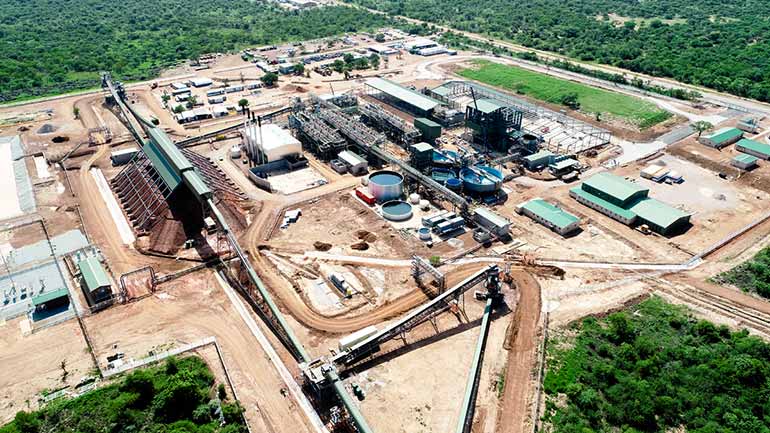Fluorspar supply for refrigerants – is relief in sight?
2nd August 2019
While the F-gas phase down has had a specific marked effect on European HFC refrigerant prices, global prices are most affected by the price of the mineral fluorspar.
Fluorspar is the commercial name for the mineral fluorite (calcium fluoride), and is the basic feedstock for all fluorine-based chemicals.

In this article by Mike O’Driscoll (right), director and co-founder of IMFORMED, the networking and market research platform for the global non-metallic minerals industry, looks at the current supply situation and possible future trends for this vital component.
Without fluorspar, you can’t make hydrofluoric acid (HF), and without HF, you can’t make the extensive range of fluorochemicals that are required for many industrial and domestic applications, including the vital compounds used in refrigeration and air conditioning gases.
However, there are relatively few commercially developed fluorspar sources worldwide, and the largest producing country is now facing cutbacks, while new suppliers have been facing delays in start-up. Tightness in supply and high prices have continued from 2018 into 2019, with 2020 looking to do the same unless more capacity emerges.
Will the likes of Chemours, Daikin, Honeywell, and Arkema be able to secure adequate supplies of fluorspar?
Fluorspar input to fluorochemicals
The two primary commercial grades of fluorspar produced and traded are acid grade or acidspar (+97% CaF2), and metallurgical grade, or metspar (60-96% CaF2; so-called “ceramic grade” can range 94-96% CaF2)
Acidspar, accounts for approximately 60-65% of total fluorspar production with the two main applications being: the manufacture of hydrofluoric acid (HF) – the primary source of all fluorochemicals; and in aluminium production – used to produce aluminium fluoride (AlF3) which acts as a flux to lower the bath temperature in the manufacture of aluminium.
In addition to refrigerants and propellants, fluorochemical markets include electrical and electronic appliances, metallurgical industry (extraction, manufacture and processing), Li-ion batteries, pharmaceuticals, polymers, and agrochemicals.
Metspar accounts for approximately 40-37% of the total fluorspar production with the main application as a flux in steelmaking.
Fluorochemicals is fluorspar’s largest market. Fluorspar demand for 2018 was estimated at 6.33m tonnes, with HF accounting for 40%, steel, 30%, aluminium, 25%, and others, 5%.
Overall, production of fluorocarbons is estimated to have consumed approximately 1m tonnes of HF in 2017, requiring over 2m tonnes of acidspar.
HF overall worldwide demand remained steady at 1.2m tonnes in 2018, with China still supplying 45% of world output, North America, 25%, and Europe, 13%.
However, plant shutdowns in China owing to environmental pressures have reduced output and exports in recent years. In response, Japan has increased production.
The fluorocarbon market is constantly in the environmental control spotlight, with many countries, and especially the European Union and the USA, introducing restrictions on the use of certain HFCs and HCFCs due to their global warming potential.
HFOs, the low GWP alternatives, are also produced using HF.
Source
China remains the world’s top fluorspar producer, accounting for around 60% of total world output of 5.8m tonnes in 2018, followed by Mexico, South Africa, Mongolia, Vietnam, and Spain. There has been some recent production emerging from Pakistan, Thailand, and Myanmar.
Fluorspar supply for 2018 was reasonably tight, mainly owing to mine closures from environmental controls in China, and limited and delayed production from new and emerging producers in Canada, South Africa, and Asia.
This looks set to continue through 2019 and even 2020 unless new capacity comes on stream soon.
China’s hold on global export markets for fluorspar has declined significantly in recent years from the peaks of 2010-11. For the first time, in 2017 and continued in 2018, China became a net importerof fluorspar: over 500,000 tonnes imported against just over 400,000 exported in 2018 – a reflection of the squeeze on domestic supply by environmental controls as well as increased domestic demand from a growing fluorochemicals market. The trend is expected to continue in 2019.
China’s sharp increase in metspar imports was sourced mainly from Mongolia, but also Myanmar. Acidspar was imported from Mexico and South Africa.
The leading world acidspar exporters are Mexico, Vietnam, South Africa and China; for metspar it is Mongolia, Mexico, and China.
The main regional markets for acidspar are the USA, Italy, India, and Germany, reflecting the main centres of fluorochemical manufacturing.
The tightness in global supply in 2018 resulted in sharp price increases for acidspar which peaked at over $500/t, this has carried over into 2019, with reports that metspar prices were also rising and even overtaking acidspar levels at up to $550/t.
US net import reliance on Chinese fluorspar has declined from a dominant 52% in 2009 to a mere 6% in 2018, being eclipsed by increasing imports from Mexico (at 69%), and most recently, although on a smaller scale, from Vietnam.
Although the US raised tariffs from 10% to 25% on US$200bn of Chinese products on “List 3” in May 2019 which includes many minerals, fluorspar (acidspar and metspar) was excluded, while aluminium fluoride and hydrofluoric acid remain on the list.
In contrast, there was certainly more of a risk from US President Trump’s recent threats to impose 5% punitive tariffs on all goods imported from Mexico beginning 10 June 2019.
As it turned out, Trump backed off his plan, announcing on 7 June that the USA had reached an agreement with Mexico, and there will be a renegotiated United States-Mexico-Canada Agreement (USMCA). So US fluorspar consumers will feel somewhat relieved…..for now.
New sources emerging

Depleting high quality fluorspar reserves, high cost of acidspar production, and likely continued pressure and perhaps further capacity reductions in China, combined with continuing demand for fluorspar in chemical, steel and aluminium markets mean that there is a case for alternative and new fluorspar sources to come on line.
The two players ahead of the pack are Sepfluor Ltd and Canada Fluorspar Inc. However, each has experienced start-up delays. But prospects for progress are good.
In South Africa, SepFluor’s ZAR1.7 bn(US$122m) Nokeng Fluorspar Mine open pit mine and concentrator was finally commissioned and ramping up to commercial production (180,000tpa acidspar capacity) by end of July 2019.
Canada Fluorspar Inc (CFI) is ramping up production at its St Lawrence, Newfoundland, facility with a nominal target of full production capacity of 200,000 tpa acidspar. CFI is planning a new location for development of a vital marine terminal near its mining property.
By the end of 2019 we shall know if these new sources are fully on stream, if they are not, 2020 may see continued tight supply and upwards pressure on prices for fluorspar.
All the key trends and developments in the entire fluorspar supply chain from source to market will be examined and discussed at IMFORMED’s upcoming Fluorine Forum 2019 in Prague from 21-23 October. Papers to be presented include:
The evolution of refrigerant gas and the role of Chemours in the market by John Zielinski, executive buyer fluoroproducts, Chemours, USA
Changes in refrigerant use and its impact on the air conditioning and refrigeration markets by Andrea Voigt, director general, European Partnership for Energy & the Environment, Belgium
Trade & tariffs: Where we’ve been and where we might go by Ray Will, director of specialty & inorganic chemicals consulting, IHS Markit, USA.
Full details at www.imformed.com.







